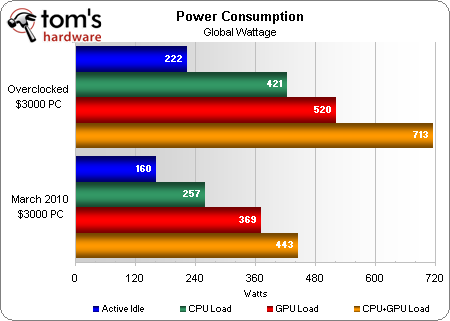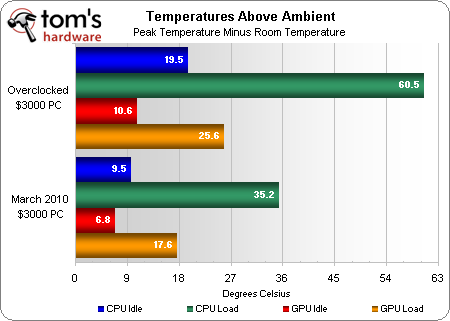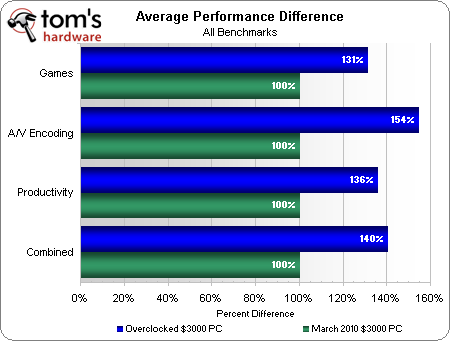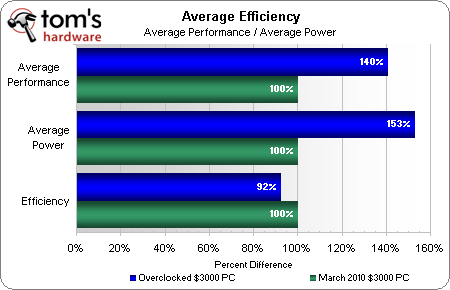System Builder Marathon, March 2010: $3,000 Extreme PC
Power, Heat, And Efficiency
Efficiency is a comparison of work completed to energy used. Overclocking forces higher power consumption, but can still result in improved efficiency whenever performance is increased by a greater amount than power consumption. We start our analysis by checking the amount of power used at the source.
At 160W, idle power consumption was already high before we overclocked. Pushing our processor 61% above stock had only a moderate impact on idle power use, yet its full-load power went up by 64%.
A drastic increase in full-load CPU temperature could have a greater effect on power consumption than the moderate increase in voltage, since semiconductors become less resistive as they heat up. Once again, we remind readers that this temperature was reached by running eight threads of Prime95 simultaneously over the period of several hours and that operational temperatures were much cooler.
The liquid-cooled graphics card amazingly operates at only 25.6 degrees Celsius over ambient at loads and settings, a full 66% lower than temperatures typically achieved with air-cooled cards. The drastic difference in CPU and GPU temperatures is probably due to a flow restriction at the GPU water block, where the CPU block relies on high volume, while the GPU block relies on high pressure. Were we to add a second graphics card, we’d probably connect its cooling lines parallel to the first card for increased flow through the water block and radiator.
Because some of our games showed CPU limits at default settings, a gaming performance increase of 31% at a 31% GPU overclock appears to have occurred by happenstance. In other words, the same GPU clock probably would have provided far lower performance gains had it not been accompanied by a significant CPU overclock, though many hours of additional testing would be required to show an exact numeric correlation.
A 40% increase in performance corresponds to a 53% increase in power consumption, dropping the overclocked configuration’s efficiency by 8%. While certainly no “green” PC, we’re sure there are many users who would gladly pay the higher power bill for this performance improvement.
Current page: Power, Heat, And Efficiency
Prev Page Benchmark Results: Synthetics Next Page ConclusionGet Tom's Hardware's best news and in-depth reviews, straight to your inbox.
-
zoemayne More than 64GB is gonna be needed for multiple games and good apps... those ssd's can only handle 5 games max.Reply -
Crashman zoemayneMore than 64GB is gonna be needed for multiple games and good apps... those ssd's can only handle 5 games max.Reply
You're repeatedly ignoring that it's 128GB, not 64GB, because the article repeatedly states that the drives are striped (Level 0) by the RAID controller. And there's a terabyte of added storage on top of that for stuff that isn't programs. -
anamaniac Nice as it is, my only complaint is that...Reply
Overclocked 5970 + i7 on a single 120.2?
ARE YOU MAD!
Likely.
Well, I personally would have dropped something else and gone for a 120.3 or 140.3 radiator. =D
Hell, maybe even a 140.4 radiator, but then again, I like my system to run chilly and silent. It's also be very difficult to mount a 140.4 I assume. Maybe I could jack a radiator form work, I think it's about 1 metre by 3 metres by half a metre. Granted, it's for industrial use, but just for one day, please boss please?
Good results on the i7 though. Decently low voltage and still managed to reach 4.3GHz. My i7 is a lemon. It makes me sad. =(
Also an impressive overclock for a 5970.
At this kind of power, you should be testing multi monitor resolutions. I have a 5770 and I run 7 megapixels, you use a 5970 and only run 4 megapixels.
Looking forward tho the $1,500 build. See how my build compares to one six months older on a similar budget (and cry). -
tacoslave http://www.youtube.com/watch?v=U9l-XQzdRGg&feature=related this is what happened when i saw that 5970 in action "I CAME"Reply -
Crashman Reply9490893 said:Nice as it is, my only complaint is that...
Overclocked 5970 + i7 on a single 120.2?
ARE YOU MAD!
Well, the explanation is in the conclusion, the builder wanted redundant storage instead of the big radiator but chose neither, leaving enough room in the budget for anyone who wanted to copy the build to make their own upgrade choice.
But what's not in the budget is that the water was never hot, it was barely warm. The problem with running the CPU at 100% load and the GPU at 100% load is that the water temperature went up by around 10 degrees...we're talking about going from the 30's to the 40's here at full load. The article points to the GPU cooler as a likely flow restriction so I have three solutions:
Solution 1: Add 1/2" by 3/8" adapter T's and cool the chipset block, parallel to the GPU block. That would allow some of the water to bypass the GPU cooler, which is OK since the GPU was always cold. But 1/2" by 3/8" T's are hard to find outside of a hardware store, and Newegg certainly doesn't have them.
Solution 2: Switch to a 3-fan radiator. A 4-fan unit won't fit nicely into that case, and making an ugly system wasn't considered a solution.
Solution 3: Add a second liquid-cooled 5970 parallel to the first. Get twice the GPU power and completely unblock the lines in the process. The GPUs would run slightly hotter when each gets only half the water, but at least the CPU block's flow won't be restricted. And...since it's probably adding another 10 degrees to the coolant...stick the three-fan radiator in there as well. For FOUR grand you could have a KILLER system!
OK, so solution 1 is the cheapest, but you have to admit solution 3 is tempting...
-
Sihastru I kinda like it. Dramatic power increase for the overclocked components. But also dramatic performance increase.Reply
Another solution to the constricted water flow would be to change the block on the 5970.
This build gets one and a half thumbs up from me, not that anyone cares...





